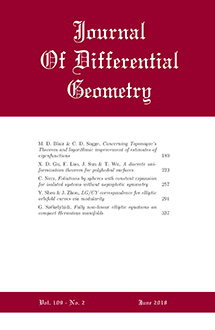Abstract
On a (pseudo-)Riemannian manifold $(\mathcal{M}, g)$, some fields of endomorphisms, i.e. sections of $\mathrm{End}(T \mathcal{M})$, may be parallel for $g$. They form an associative algebra $\mathfrak{e}$, which is also the commutant of the holonomy group of $g$. As any associative algebra, $\mathfrak{e}$ is the sum of its radical and of a semi-simple algebra $\mathfrak{s}$. This $\mathfrak{s}$ may be of eight different types; see C. Boubel, The algebra of the parallel endomorphisms of a pseudo-Riemannian metric: semi-simple part. Then, for any self adjoint nilpotent element $N$ of the commutant of such an $\mathfrak{s}$ in $\mathrm{End}(T \mathcal{M})$, the set of germs of metrics such that $\mathfrak{e} \supset \mathfrak{s} \cup \{ N \}$ is non-empty. We parametrize it. Generically, the holonomy algebra of those metrics is the full commutant $\mathfrak{o}(g)^{\mathfrak{s} \cup \{ N \} }$ and then, apart from some “degenerate” cases, $\mathfrak{e} = \mathfrak{s} \oplus (N)$, where $(N)$ is the ideal spanned by $N$. To prove it, we introduce an analogy with complex differential calculus, the ring $\mathbb{R}[X]/(X^n)$ replacing the field $\mathbb{C}$. This treats the case where the radical of $\mathfrak{e}$ is principal and consists of self adjoint elements. We add a glimpse in the case where this radical is not principal.
Citation
Charles Boubel. "On the algebra of parallel endomorphisms of a pseudo-Riemannian metric." J. Differential Geom. 99 (1) 77 - 123, January 2015. https://doi.org/10.4310/jdg/1418345538
Information





